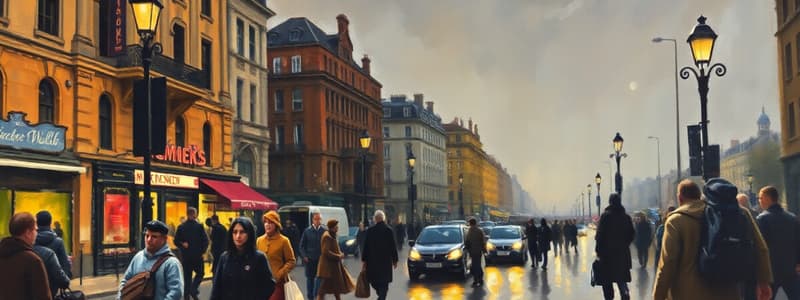Podcast
Questions and Answers
Which factor primarily drives rapid population growth in South-East England?
Which factor primarily drives rapid population growth in South-East England?
- Government policies promoting higher birth rates.
- Industrial expansion and increased job opportunities.
- Increased agricultural output and rural development.
- International migration and internal migration from other parts of the UK. (correct)
South Wales has experienced population growth due to new industrial development.
South Wales has experienced population growth due to new industrial development.
False (B)
What is the primary reason for the population decline in North-East England?
What is the primary reason for the population decline in North-East England?
Economic challenges and the decline of heavy industry, leading to outmigration of younger people seeking opportunities elsewhere.
The decrease in population and increase in older age groups in South Wales highlights the social and economic impacts of ______.
The decrease in population and increase in older age groups in South Wales highlights the social and economic impacts of ______.
Match each region with its primary demographic or economic challenge:
Match each region with its primary demographic or economic challenge:
Which factor has MOST significantly shaped London's cultural landscape, contributing to its vibrant, multicultural environment?
Which factor has MOST significantly shaped London's cultural landscape, contributing to its vibrant, multicultural environment?
Southall's nickname, 'Little India,' primarily reflects its high concentration of international tourists visiting from India.
Southall's nickname, 'Little India,' primarily reflects its high concentration of international tourists visiting from India.
What challenges does Tower Hamlets face due to its diverse population and high population density?
What challenges does Tower Hamlets face due to its diverse population and high population density?
The annual carnival in __________ is a well-known celebration of Caribbean culture, attracting visitors from around the globe.
The annual carnival in __________ is a well-known celebration of Caribbean culture, attracting visitors from around the globe.
Match the region with its corresponding characteristic:
Match the region with its corresponding characteristic:
In the context of Notting Hill, what complexities arise from urban regeneration?
In the context of Notting Hill, what complexities arise from urban regeneration?
Migration from the South of England to the North is primarily driven by cultural attractions and a richer nightlife.
Migration from the South of England to the North is primarily driven by cultural attractions and a richer nightlife.
What challenges arise in Tower Hamlets because of its dense population and diversity?
What challenges arise in Tower Hamlets because of its dense population and diversity?
Flashcards
South-East England Population
South-East England Population
High population density, rapid growth due to migration, urban expansion, and increased demand for housing and services in South-East England.
South-East England Density
South-East England Density
Population density of approximately 420 people per square kilometer defines the area.
South Wales Population
South Wales Population
Industrial decline leading to job losses, demographic shifts, decreased population, and an aging population in South Wales.
South Wales Density
South Wales Density
Signup and view all the flashcards
North-East England Population
North-East England Population
Signup and view all the flashcards
Cultural Diversity
Cultural Diversity
Signup and view all the flashcards
Migration
Migration
Signup and view all the flashcards
Social Clustering
Social Clustering
Signup and view all the flashcards
Cultural Enclaves
Cultural Enclaves
Signup and view all the flashcards
Urban Demographics
Urban Demographics
Signup and view all the flashcards
Service Provision
Service Provision
Signup and view all the flashcards
Lived Experience
Lived Experience
Signup and view all the flashcards
Urban Regeneration
Urban Regeneration
Signup and view all the flashcards
Study Notes
- London's cultural diversity is a result of migration, with over 300 languages spoken among its 9 million residents.
Southall, London
- Southall, also known as 'Little India', shows how migration and social clustering create culturally rich neighborhoods.
- It has a high concentration of South Asian residents and businesses.
Tower Hamlets, London
- Tower Hamlets has a high population density of about 15,000 people per square kilometer.
- The area has a diverse population with many residents from ethnic minority backgrounds.
- It faces challenges in service provision, housing, and social cohesion.
Notting Hill, London
- Notting Hill showcases urban regeneration and community identity, transforming from a deprived area into a cultural hub.
- The annual Caribbean carnival attracts visitors worldwide.
- Regeneration has led to improved living conditions and community identity, but also gentrification concerns.
North of England
- The North of England has experienced slower economic growth and a population growth rate of around 3.8%.
- Internal migration from the South has occurred due to economic opportunities and better living standards.
- This migration has contributed to regional disparities.
South-East of England
- The South-East of England has a population density of approximately 420 people per square kilometer.
- The South-East has experienced rapid population growth because of international and internal migration.
- This growth has led to urban expansion and increased demand for housing and services.
South Wales
- South Wales has faced industrial decline, resulting in job losses and demographic shifts.
- The area has a population density of around 149 people per square kilometer.
- There has been a population decrease and an increase in older age groups.
North-East of England
- The North-East of England has a population density of approximately 67 people per square kilometer.
- The area has experienced economic challenges, including the decline of heavy industry and manufacturing.
- This has led to population decline and outmigration of younger people seeking opportunities elsewhere.
Studying That Suits You
Use AI to generate personalized quizzes and flashcards to suit your learning preferences.




